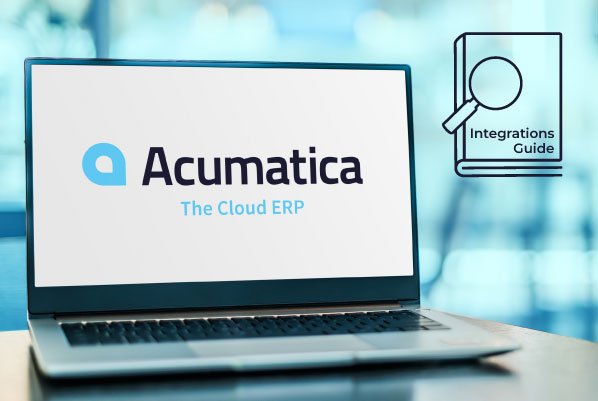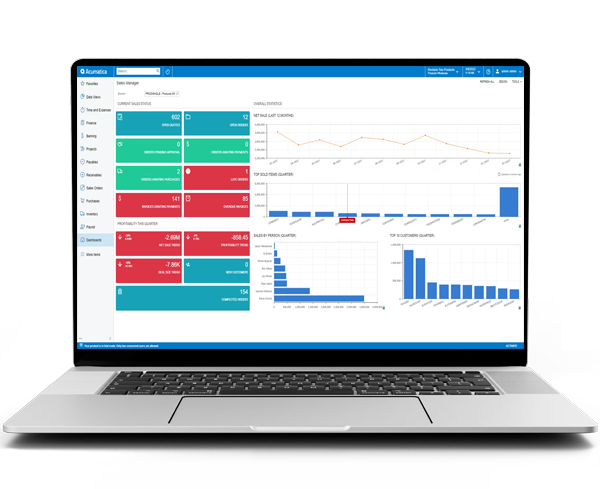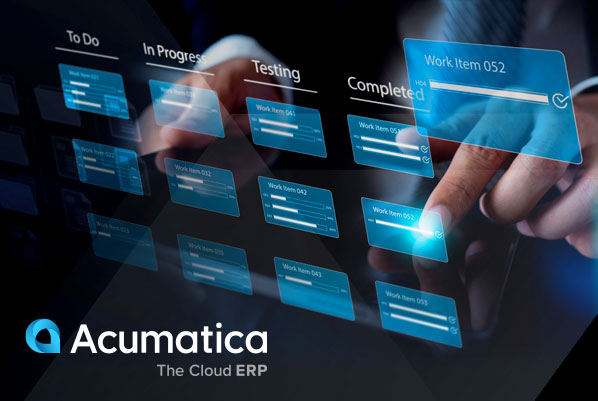BLOG | 7 MIN READ
The Best Acumatica Integrations Guide
Discover our top integration recommendations that will elevate your Acumatica experience. Unlock the power of Acumatica integrations.

TABLE OF CONTENTS
- Why Are Acumatica Integrations Important?
- What Are the Most Popular Acumatica Integrations?
- Accounts Payable Integrations
- Accounts Receivable Integrations
- E-Commerce and POS Integrations
- Reporting & Analytics Integrations
- Acumatica CRM Integrations
- Tax Compliance Integrations
- Manufacturing Integrations
- Logistics Integrations
- Construction Integrations
- Human Resources Integrations
- Choosing the Right Acumatica Integrations
- Acumatica ERP Demo Center
While Acumatica works well on its own to handle financials, operations, workflows, and more, the software is designed to grow alongside your business with help from integrated third-party applications. These integrations expand on Acumatica’s existing ERP features and introduce new ones to satisfy the needs of any business.
Little to no coding experience is required to take advantage of Acumatica’s integrations—all the applications available through Acumatica’s Marketplace offer plug-and-play simplicity to help you grow your business faster
Why Are Acumatica Integrations Important?
Acumatica’s standalone features run the gamut of typical ERP fare—core financial features like GL, AR, and AP, as well as management for projects, time and expense, service orders, and more. Integrated solutions can expand the features in these key ERP areas and flesh out adjacent focus areas excluded from an out-of-the-box Acumatica installation. Integrations might introduce e-commerce tools, sales and marketing platforms, and more.

What Are the Most Popular Acumatica Integrations?
Accounts Payable Integrations
Acumatica’s built-in AP automation streamlines the invoice approval process, accepts and manages prepayments, and scans records for inconsistencies and other anomalies. However, companies with diverse sales processes and complex customer and vendor relationships may need more features to save time and further automate the flow of accounts payable data. These third-party tools flesh out Acumatica’s existing AP features to offer accounting teams more depth.
► Our Top Picks:
TRAILD is an AP automation tool that enables three-way matching for purchase orders and receipts. With the power of artificial intelligence, TRAILD protects businesses by reviewing invoices for errors and anomalies.
AvidXchange integrates with Acumatica to automate invoice processing, enable electronic payments, and improve visibility into AP workflows. This integration helps businesses process payments more efficiently by syncing vendor bills and payment information between the two systems.
Accounts Receivable Integrations
Acumatica has built-in AR functionality to create invoices, track payments, manage collections, and generate reports. However, an integration might be beneficial for companies in unique industries or organizations that use third-party payment processors like Stripe and PayPal.
Our Top Picks:
Paystand enables Acumatica users to automate and accept multiple payment methods, including ACH, credit cards, and bank transfers. Paystand speeds up cash flow and improves financial visibility while saving time for teams.
eBizCharge is a PCI-compliant credit card processing integration built natively within Acumatica. The tool includes email payment links and online portals for customers to securely pay invoices via credit cards, debit cards, and ACH checks.
E-Commerce and POS Integrations
Acumatica Retail Edition is built for full-time retailers, but what about companies that blend online retail with other services or those that need advanced retail capabilities beyond what Acumatica offers? These organizations can get the best of both worlds by integrating Acumatica’s Retail or General Business Editions with third-party tools for payments and e-commerce.
► Our Top Picks:
Shopify is an e-commerce platform designed for digital storefront management. When integrated with Acumatica, Shopify synchronizes product and sales data, making it easy for customers to get the products they want.
Amazon Marketplace brings all the capabilities of Amazon’s e-commerce to Acumatica. This tool lets Acumatica users manage digital storefronts and reach more customers while Amazon handles product storage and shipping.
Kensium offers a slew of integration-ready products that bring e-commerce to Acumatica, including PayPal invoice and payment plugins and an omni-channel point of sale system that expands purchase options for customers.
BigCommerce’s native integration with Acumatica draws from Acumatica-based data to provide a complete picture of inventory, sales, and more. BigCommerce also streamlines the purchasing process by offering customers product variants, made-to-order items, and more.
Reporting & Analytics Integrations
Acumatica comes equipped with real-time data visualization tools like dashboards, financial and operational reports, and business insight tables. Still, some companies might consider an integration for data consolidation or advanced data visualization.
► Our Top Picks:
Velixo is a reporting tool that pulls real-time data from Acumatica into Excel, then allows users to automate financial statements, consolidate multi-entity data, and create dynamic reports with minimal manual effort.
DataSelf Analytics brings pre-built and custom report templates to Acumatica with solutions for business intelligence and data warehousing. The integration between Acumatica and DataSelf Analytics taps into analytics libraries for robust reporting and establishes a secure data warehouse to store and load data.
Acumatica CRM Integrations
While ERP software handles the background operations of day-to-day work, such as accounting and project workflows, it lacks the conversion and closing capabilities of customer relationship management (CRM) systems. Sales, marketing, and customer experience teams rely on CRM software to facilitate positive customer interactions and ensure deals close quickly. Acumatica has some basic CRM features, but integrating the software with a tried-and-true CRM delivers all the features your business needs.
► Our Top Picks:
HubSpot is a popular CRM with modules for sales, marketing, customer service, and more. Its marketing automation tools are particularly popular and help users bring in leads from multiple channels. Integrating HubSpot with Acumatica is perfect for collaborative teams that want to marry customer data with operational and accounting information.
Salesforce is a CRM suite that centralizes sales data and automates daily tasks. By connecting Salesforce with Acumatica, businesses can improve workflow automation, enhance customer insights, and eliminate manual data entry, leading to more efficient sales and financial operations.
Tax Compliance Integrations
Cloud software like Acumatica makes compliance a breeze because its automatic updates can immediately accommodate new regulations. However, for highly regulated industries with strict tax compliance requirements, Acumatica’s base software may not offer every feature they need for sales and use taxes, excise taxes, and more. Tax add-ons can expand Acumatica’s financial capabilities while ensuring compliance every step of the way.
► Our Top Pick:
Avalara is tax compliance software for Acumatica users with general business needs and those in specialized industries like construction, distribution, and manufacturing. Avalara ensures compliance for transactional taxes like sales and use, VAT, excise, and more.
Manufacturing Integrations
Acumatica’s General Business solution is a great fit for most businesses, but manufacturers may need additional tools to track raw material supply, vendor invoices, and production processes. Acumatica offers several solutions, including a specialized edition for Manufacturing and a handful of unique third-party integrations.
► Our Top Picks:
CADLink is a custom connector that creates a two-way sync between Acumatica and a CAD, PDM, or PLM system. This connector ensures that Acumatica users can access key data regarding bill of materials, stock, item records, and more. It even embeds drag-and-drop features for production routing and other operations into Acumatica.
Protected Flow Manufacturing (PFM) is LillyWorks’ custom PFM for Acumatica. The integration between these systems offers real-time visibility into work orders, shop floor activities, production, and more.
Logistics Integrations
Distributors need to track every item in every package moving into and out of their warehouses. Let Acumatica handle accounts and operational data while integrated logistics systems manage high-volume shipping across multiple carriers to ensure fulfillment. Or expand Acumatica Distribution Edition’s handling of the quote-to-cash cycle with automation tools for faster, more accurate deliveries.
► Our Top Picks:
ShipHawk is an automated shipping and fulfillment tool for Acumatica that offers multi-carrier shipping, smart packing, and automated rate shopping. By pulling order and shipment details from Acumatica, ShipHawk finds the best combination of rates and carriers to expedite the shipping process.Savant Software has developed a custom warehouse management system (WMS) for Acumatica. This tool enhances inventory control, automates warehouse operations, and makes order fulfillment more efficient by synchronizing warehouse data between the two systems.
Endpoint Automation Solutions (EAS), formerly Scanco, connects with Acumatica to offer real-time visibility into inventory, stock, item locations, and more. In tandem, these solutions help teams run lean warehouse operations with less need for manual oversight.
Construction Integrations
Acumatica’s Construction Edition provides project management, accounting, and job cost tracking, but teams on the General Business Edition or those with advanced construction needs can greatly benefit from third-party integrations.
► Our Top Picks:
STACK Takeoff & Estimating helps Acumatica users generate takeoffs, estimate job costs, and customize client proposals. The material and labor estimates generated by STACK automatically sync with related fields in Acumatica, such as project budget and financials, reducing the need for manual data entry.
JobPlanner Project Management is a flexible construction project management solution that streamlines project stages. When integrated with Acumatica, JobPlanner automates scheduling and communicates key information like labor allocation and project timelines with the ERP.
Human Resources Integrations
Acumatica’s payroll features are helpful for accounting and HR teams, but how can HR teams get the most out of an Acumatica investment? The solution is to integrate HR-specific software with Acumatica. By pairing up operational and financial software like Acumatica with a human capital management (HCM) system, HR teams can boost employee engagement and productivity while saving time.
► Our Top Picks:
Inova bridges the gap between HR and accounting teams. Pairing it with Acumatica means that key information like hours worked, benefits, tax details, and more are synchronized across both systems. This improves payroll accuracy and helps teams better manage finances and human capital.
ADP’s Workforce Now Connector is an HCM system that communicates payroll transactions, tax data, and employee information with Acumatica. This gives HR and accounting teams easy access to customer data within both systems, minimizing errors associated with redundant manual data entry.
Lumber is a construction-specific HR and payroll solution that integrates with Acumatica to manage workforces. From tracking hours worked to assigning project tasks, Lumber works with Acumatica to help construction companies boost productivity and get the most out of each employee.

Choosing the Right Acumatica Integrations
A complete list of more than 260 integrations can be found on the Acumatica Marketplace. Don’t see the feature you’re looking for? Don’t worry—Acumatica boasts an open application programming interface (API), which helps it pair with existing third-party software and makes it easy to customize. Developers can access Acumatica’s API documentation to produce custom integrations and new modules for any business.
Curious about what Acumatica could do for your business? Are you struggling to tie your current Acumatica tech stack together? A dedicated and experienced software partner like Cargas can help you succeed with Acumatica. Reach out today to learn more about the integrative capabilities of Acumatica!



